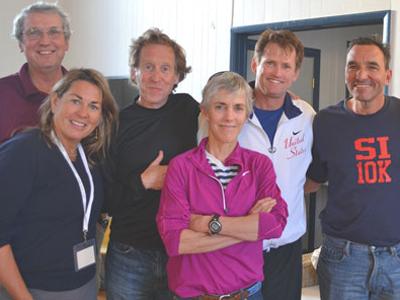Joyful Day Turned Ugly in Boston

Dr. Frank Adipietro and his wife, Mary Ellen, the race director of the Shelter Island 10K, were enjoying (he as a participant, she as a finish-line spectator) Monday’s marathon in Boston when bombs on Boylston Street turned what had been a joyous occasion into an ugly, bloody one.
When the first bomb detonated, Ms. Adipietro, a registered nurse, and hundreds of others in the stands across the street were shaken by the explosion’s concussive force. Moments later, about a half-mile away, Dr. Adipietro (an anesthesiologist who oversees a popular pain-management center at Eastern Long Island Hospital in Greenport), who was on pace to finish the 26.2-mile race in 4 hours and 20 minutes — his goal — was halted by a policeman. The officer, Dr. Adipietro said during a conversation on the couple’s way home from Boston Tuesday morning, gave no explanation.
“You can’t stop me!” the 55-year-old veteran of 30 marathons said, resuming his stride.
But within moments, the rush of ambulances, fire engines, and emergency vehicles to the scene near the marathon’s finish line made it painfully clear, he said, that “something major” had happened. He was three minutes from the finish line when he acceded to a second police officer’s urging that he and his fellow runners get off the course, that a bomb had gone off.
“It was bedlam,” Dr. Adipietro said. “I told the guy my wife was at the finish line and that I needed to know how she was. ‘I can’t help you,’ he said.”
“I didn’t know what to do. Mary Ellen knew my pace — she’s run many marathons too. I was thinking something bad, or worse, had happened to her, and she was thinking the same thing about me. . . . It was a heart-stopping moment for both of us.”
As it was, Ms. Adipietro and her fellow spectators in the stands — some of whom were said to be children from Sandy Hook Elementary School in Newtown, Conn. — were spared because they were 50 feet removed from the blast across the street. In the midst of the blood and carnage and panicking adults, “she was amazing,” said her husband. “Some of the adults in the stands were panicking — running, screaming, crying — but Mary Ellen doesn’t panic. She worked to calm everybody down and to shepherd children who’d been left alone in those moments by their adult supervisors to safety. She kept her head and made sure the stands were evacuated in an orderly fashion. She made sure the children were reunited with the adults who were supposed to be looking after them. She did an amazing, beautiful job.”
Asked if his wife had helped to treat the injured, Dr. Adipietro, who, had he not been diverted from the course might well have found himself in the sights of the second explosion, said, “She offered, she said, ‘I’m a nurse, I’d be happy to help.’ They thanked her for her offer, but didn’t let her because she wasn’t a volunteer.”
Dr. Adipietro tried to get to the finish line by way of “a parallel street, Newbury,” but ultimately found his way blocked (“Boylston had been evacuated, there was nobody in the stands”), and returned to their hotel, the Four Seasons, “about three-quarters of a mile from the finish line. . . . I found her there — visibly shaken. She still can’t talk about it. That’s why I’m doing all the talking with you. She saw a person with both legs blown off. . . . I’m so glad she was able to help. That’s what she’s about, helping people.”
“It was terrible, just terrible,” he continued. “They took the most joyful day, a day of celebration — it was Patriots Day, you know, and there were runners there from all over the world — and, in a matter of moments, turned what had been such a joyous day for hundreds of thousands into a day of tragedy, of profound sorrow.” He thanked God that their 11-year-old son, Liam, was not there.
The Adipietros, who first met at the Shelter Island 10K in 1984, have been responsible for persuading some of America’s all-time elite distance runners — Bill Rodgers, Joan Benoit Samuelson, Frank Shorter, and Kim Jones among them — to take part in Shelter Island 10Ks in recent years.
Asked if any of them had been at Boston, Dr. Adipietro said, “Joan was there — she ran in the race. I just spoke with her. She called to see if I was alive. And of course I was glad to hear she was okay too.”
“Oh, yes,” he said in answer to another question, “the marathon will survive. It’s an honor to run in it. It’s part of the American way of life, a way for people to come together and to celebrate each other. It makes a city one big family. Definitely, it will survive. They’ll have to make some changes, obviously, but I’ll definitely be there next year, no question. Runners run. Nothing can stop us.”
